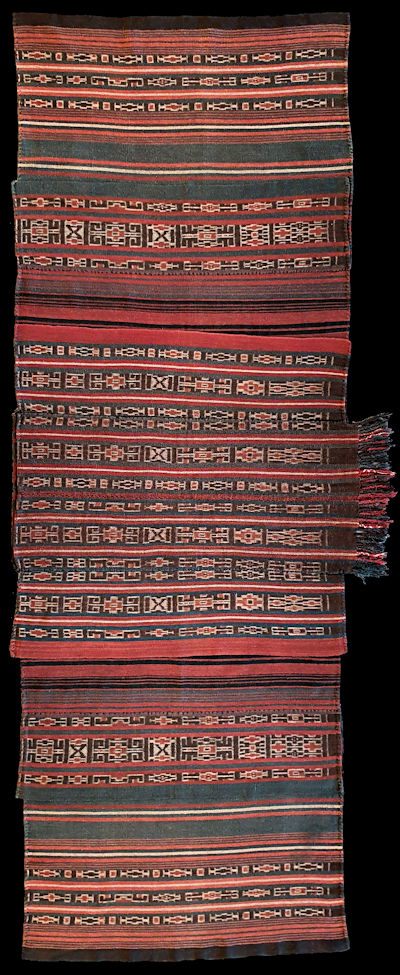| |
 
 | | | |
330 Timor, East Timor
Tais sela (horse blanket)  
| | Locale: | Suai Loro, Covalima | | Period: | 1940s | | Yarn: | Cotton, hand-spun, medium | | Technique: | Warp ikat | | Panels: | 5 | | Size: | 95 x 213 cm (3' 1" x 6' 11") LW: 2.24 | | Weight: | 1350 g (47.6 oz), 334 g/m2 (1.09 oz/ft2) | | Design: | This horse blanket, tais sela, consists of five panels that were stitched together in such a manner that they party overlap, creating a largely double-layered cloth. All panels have a marked banded structure. Some of the motifs are believed to have been inspired by patola, though exactly which type could not be established. Other motifs, particularly the 'loom' motif (a central box with inward curling hooks on the sides) is most common in the Tanimbars and also found in other parts of the Moluccas. The natural dyes are deeply saturated. Though the cloth is whole, without holes or thin spots, microscopy shows extreme yarn degradation, probably as a result of abrasion and washing. | | Comment: | This horse blanket in 2019 was divested by the Tamukung (local ruler), Raja Vincen Luruk, of Suai-Loro to obtain funds for the restoration of the family's adat house. It was made by his mother, Teresia Luruk Bouk. Such horse blankets are very rare. Only about a dozen are known, less than twenty believed to be extant. A very similar specimen is in the Georges Breguet collection. The Tamukung's father had two horses, one white, one brown, and a separate tais sela for each horse. Georges Breguet ended up with the tais sela for the brown horse, we with that for the white horse. Both the style and the weave type show great similarity to the men's wrap 327 and the sarong 328. | | Background: | Chapters on Timor and East Timor. | | Exhibited: | Timor: Totems and Tokens, Museu do Oriente, Lisbon, 2019/20. | | Published: | Timor: Totems and Tokens, 2019.
Ikat Textiles of Timor: Indonesian and Timor-Leste, 2025. | | Compare: | 327 328 | | Sources: | Most information was provided by the family of Raja Vincen Luruk. | | |

©Peter ten Hoopen, 2025
All rights reserved.
|
|


